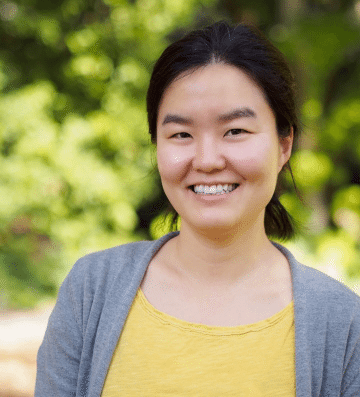
Yumi Kim
Assistant Professor
Contact Information
- yumi.kim@jhu.edu
- 385 UTL
- 410-516-6504 | Lab 410-516-6502
- Group/Lab Website
Research Interests: Chromosome dynamics during meiosis
Yumi Kim is an assistant professor in Biology whose research focuses on the molecular mechanisms that drive and coordinate meiotic chromosome dynamics. She received her Ph.D. from UCSD and did her postdoctoral work at UC Berkeley.
Accurate chromosome segregation during meiosis is essential for the transmission of stable genomes from parent to offspring. Errors in this process lead to the production of cells with an abnormal number of chromosomes or aneuploidy, and this is a major cause of miscarriages and birth defects in humans such as Down syndrome. Our lab is interested in the molecular mechanisms that ensure faithful chromosome segregation during meiosis. By combining biochemical reconstitution and structural biology with cytological and genetic analysis in the nematode C. elegans, we address fundamental questions of how homolog pairing, synapsis, and crossover recombination are executed and coordinated during meiotic prophase.
Brandt, J.N., Hussey, K.A., and Kim,Y. (2020) Spatial and temporal control for targeting Polo-like kinase during meiotic prophase. J Cell Biol 219 (11): e202006094
Hurlock, M.E., Čavka, I., Kursel, L.E., Haversat, J., Wooten, M., Nizami, Z., Turniansky, R., Hoess, P., Ries, J., Gall, J.G., Rog, O., Köhler, S., and Kim, Y. (2020) Identification
of novel synaptonemal complex components in C. elegans. J Cell Biol 219 (5): e201910043
Yu, Z.*, Kim, Y.*, and Dernburg, A.F. (2016) Meiotic recombination and the crossover assurance checkpoint in C. elegans. Semin Cell Dev Biol 54, 106-116. *Contributed equally
Kim, Y., Kostow, N., and Dernburg, A.F. (2015) The chromosome axis mediates feedback control of CHK-2 to ensure crossover formation in C. elegans. Dev Cell 35, 247-261
Kim, Y.*, Rosenberg, S.C.*, Kugel, C.L., Kostow, N., Rog, O., Davydov, V., Su, T.Y., Dernburg, A.F.†, and Corbett, K.D.† (2014) The chromosome axis controls meiotic events through a hierarchical assembly of HORMA domain proteins. Dev Cell 31, 487-502. *Contributed equally, †Co-corresponding authors
Vitre, B.*, Gudimchuk, N.*, Borda, R., Kim, Y., Heuser, J.E., Cleveland, D.W., and Grishchuk, E.L. (2014) Kinetochore-microtubule attachment throughout mitosis potentiated by the elongated stalk of the kinetochore kinesin CENP-E. Mol Biol Cell 25, 2272-81. *Contributed equally
Gudimchuk, N.*, Vitre, B.*, Kim, Y., Kiyatkin, A., Cleveland, D.W., Ataullakhanov, F.I., and Grishchuk, E.L. (2013) Kinetochore kinesin CENP-E is a processive bi-directional tracker of dynamic microtubule tips. Nat Cell Biol 15, 1079-1088. *Contributed equally.
Kim, Y.*, Holland, A.J.*, Lan, W., and Cleveland, D.W. (2010) Aurora kinases and protein phosphatase 1 mediate chromosome congression through regulation of CENP-E. Cell 142, 444-455 *Contributed equally.
Shin, W.D., Fischer, R., Kanchanawong, P., Kim, Y., Lim, J., Myers, K., Nishimura, Y., Plotnikov, S., Thievessen, I., Yarar, D., Sabass, B., and Waterman, C.M. (2010) A versatile, multi-color total internal reflection fluorescence and spinning disk confocal microscope system for high-resolution live cell imaging. Live Cell Imaging: A laboratory manual, 2nd edition Chapter 7, 119-138. Cold Spring Harbor Laboratory Press, Cold Spring Harbor, New York
Kim, Y., Heuser, J.E., Waterman, C.M., and Cleveland, D.W. (2008) CENP-E combines a slow, processive motor with a flexible coiled-coil to produce an essential, motile kinetochore tether. J Cell Biol (Cover) 181, 411-419.
Kops, G.J.P.L., Kim, Y., Weaver, B.A.A., Mao, Y., McLeod, I., Yates III., J.R., Tagaya, M., and Cleveland, D.W. (2005) Zw10 links mitotic checkpoint signaling to the structural kinetochore. J Cell Biol 169, 49-60.